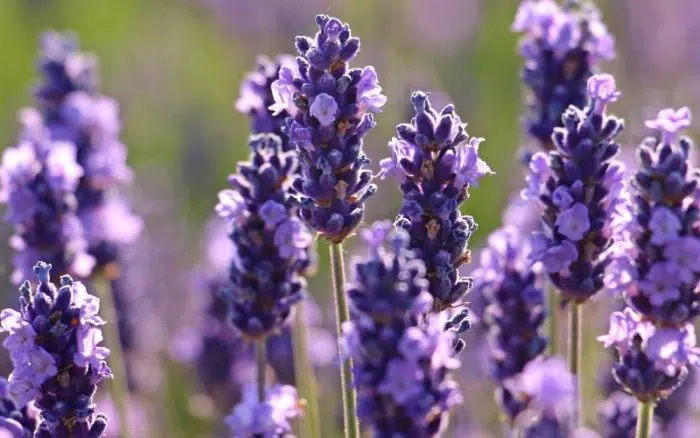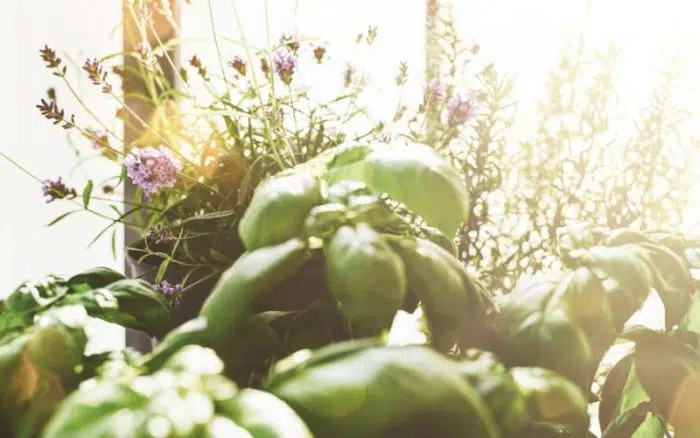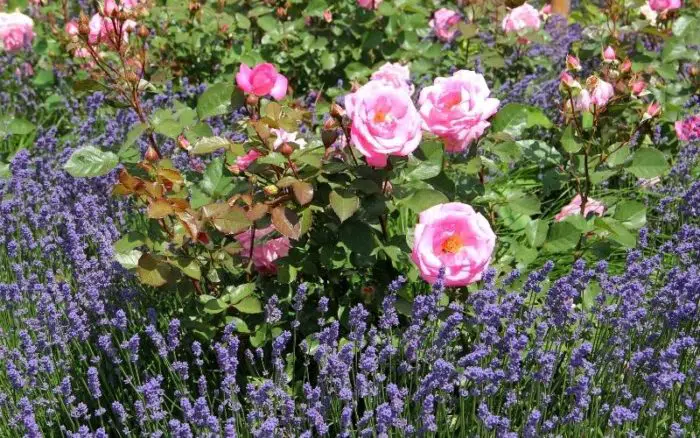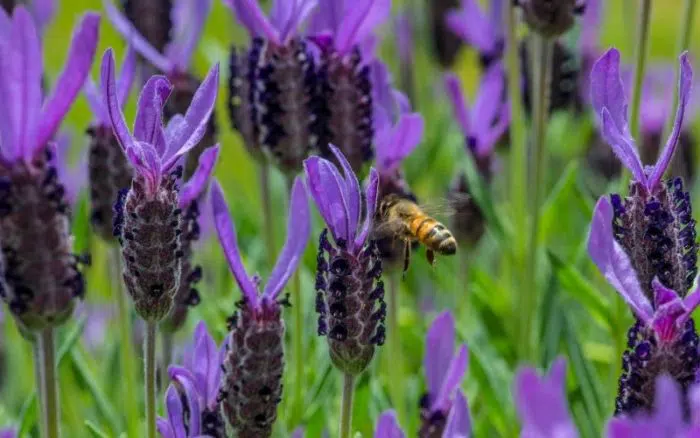I love lavender, so I’ll be planting it all over the place in my herb garden. When planning your vegetable garden, it’s always a great idea to think about pests and common fungal diseases that impact the plants you’re going to be growing.
It seems to do well with most other plants, but which lavender companion plants will it actually help?
Are you supposed to be planting lavender all in one area? Do you interweave them with plants they attract beneficial insects for? It is quite confusing, especially for a beginner like myself.
The Most Common Lavender Companion Plants
Some of the most common companion plants for lavender are garlic, tomatoes, and parsley. But there are quite a few others that don’t get as much attention from gardeners.
As I’m planning a large garden, there are a lot of things to think about – and one of the big ones is which herbs and vegetables to plant next to each other.
I had to do quite a bit of research to see which herbs and plants grow well together and which don’t. This page is a compilation of me trying to figure out what will grow well near lavender plants.

Problems That Impact the Lavender Plant
Companion planting is a two-way street. Plant A helps Plant B, and/or Plant B helps Plant A.
Because of that, I like to start with the problems that lavender has, and that will help us understand which herbs or plants will help lavender.
Thankfully, there aren’t many pests that will impact your lavender plants. You might find a whitefly here and there, but it’s very uncommon to see it damage the plant significantly. However, there is a fungal disease that is quite common with lavender.
Root Rot
Lavender can suffer some root rot if the soil becomes overly wet. This is something you can totally avoid though, as it’s caused by overwatering your plants.
So, all in all, there aren’t many issues you need to worry about when growing lavender.
Related Post: How Often to Water Lavender Plants
The BEST Lavender Companion Plants
Because it doesn’t attract much of any pests, lavender is considered a great companion for many other herbs and vegetables in the garden. It can also be found as a great addition to butterfly and pollinator gardens, and rock gardens, and is frequently used as edging for landscaping.
Here are the top lavender companions for your garden.

Basil
Another versatile herb companion is basil. Basil is said to help lavender grow stronger, but I haven’t found any proof of that.
Either way, they grow well next to each other.
Brassicas, Like Broccoli & Cabbage
Lavender is a great friend to brassicas, as it can help keep cabbage moths away. These moths lay eggs on the bottom of the leaves and the larva feed on the leaves. If you find little holes in your plants, it’s likely caused by these insects.
The strong scent of lavender can help them from making their way to your brassicas.
Lavender is also a natural repellent for slugs, which can ravage your brassicas as well.
Chamomile
Chamomile is another companion that does well with lavender bushes nearby, however, you will want to plant them in separate pots. Chamomile grows best with moist soil, while lavender likes more well-drained soil.
Celery
Lavender can help keep the celery fly and other white moths that can ravage your celery crop.
Fruit Trees
Lavender can help attract a lot of bees that pollinate fruit trees, helping them have higher yields. Companion planting lavender below the canopy of the trees can also help keep whiteflies, codling moths, and other pests from attacking the fruit trees.
Lavender does require full sun to grow, so make sure to plant them around 12 inches away from the base of the tree so they aren’t shaded out.
Mint
Mint and lavender are able to be grown nearby. Aphids can impact mint, and lavender helps keep them from doing so.
However, mint grows similar to an invasive plant, so you need to keep an eye on it to make sure it doesn’t overtake whatever is planted nearby, including lavender.
Rosemary
Rosemary grows in similar conditions to lavender, making it one of the great lavender companion herbs. They’re both drought tolerant as well as likely sandier/dry soil.

Roses
Roses and lavender have been a classic companion planting pair among gardeners. Lavender is known to keep aphids from attacking shrub roses and stressing out the plant.
Sage
Many varieties of sage enjoy growing near lavender because they both prefer hotter, dryer climates with well-draining soil.
Thyme
Rosemary grows in similar conditions to lavender, so growing them together can be a good idea. They’re both drought tolerant as well as likely sandier/dry soil, so if you were looking for a good herb to put next to lavender, thyme is one of them.
The Benefits of Companion Planting
There are a number of great benefits to finding great companion plants.
Repel Damaging Insects and Pests
Many herbs and vegetables suffer from various stresses, with one of the most common being insects and pests. If you’ve ever grown tomatoes, you know the tomato hornworm is public enemy #1. Lavender is said to be able to help tomatoes because of this.
Lavender can also keep larger animals like deer and rabbits out of your garden.
Attracting Beneficial Insects
As a companion plant, the brightly colored flowers of lavender can attract many beneficial insects and pollinators to your garden. I love watching the bumblebees have a great old time on my lavender plants, and they often move over to the tomatoes or peppers I’ve planted nearby.

Ground Cover & Providing Shade
As a shorter plant, lavender can make for a great ground cover, providing the base of other plants some shade on those hot summer days. Since it only grows 1-2 feet tall, it won’t overshadow some larger plants like tomatoes, or sunflowers, but keeps the ground a little cooler.
Improving Nutrients in the Soil
Some companion plants even add nutrients back into the soil. Peas and beans are great examples of this, as they add nitrogen back into the soil, which is super important for heavy feeders like tomatoes and peppers.
Improving Taste
Some plants can also improve the taste of others. Basil can help improve the taste of tomatoes, but if you planted mint near your cucumbers, the flavor might not be a “typical” cucumber, if you know what I mean.


